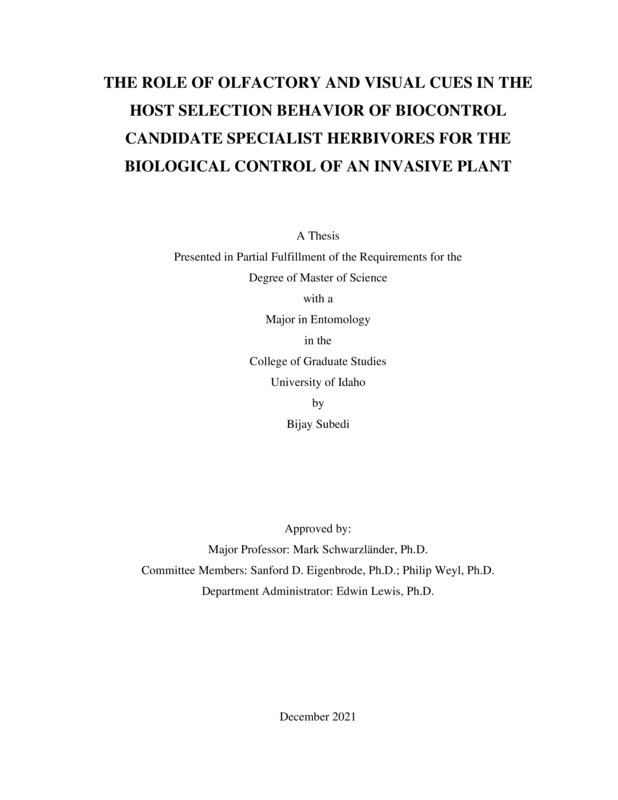THE ROLE OF OLFACTORY AND VISUAL CUES IN THE HOST SELECTION BEHAVIOR OF BIOCONTROL CANDIDATE SPECIALIST HERBIVORES FOR THE BIOLOGICAL CONTROL OF AN INVASIVE PLANT
Subedi, Bijay. (2021-12). THE ROLE OF OLFACTORY AND VISUAL CUES IN THE HOST SELECTION BEHAVIOR OF BIOCONTROL CANDIDATE SPECIALIST HERBIVORES FOR THE BIOLOGICAL CONTROL OF AN INVASIVE PLANT. Theses and Dissertations Collection, University of Idaho Library Digital Collections. https://www.lib.uidaho.edu/digital/etd/items/subedi_idaho_0089n_12086.html
- Title:
- THE ROLE OF OLFACTORY AND VISUAL CUES IN THE HOST SELECTION BEHAVIOR OF BIOCONTROL CANDIDATE SPECIALIST HERBIVORES FOR THE BIOLOGICAL CONTROL OF AN INVASIVE PLANT
- Author:
- Subedi, Bijay
- Date:
- 2021-12
- Keywords:
- Ceutorhynchus peyerimhoffi Ceutorhynchus rusticus Coleoptera Combined plant cues Isatis tinctoria Pre-alightment host selection behavior
- Program:
- Plant, Soil and Entomological Sciences
- Subject Category:
- Entomology; Biology
- Abstract:
-
Pre-release host range assessment of weed biological control agent (BCA) candidates typically rely on no-choice and choice feeding, oviposition, and development tests. However, these tests may exclude an environmentally safe BCA candidates from consideration if they can develop on nontargets that they would not colonize post-release because of the behavioral barriers. An accurate assessment of the post-release host range should, therefore, consider the host selection behavior. The seedpod weevil Ceutorhynchus peyerimhoffi and root-crown weevil Ceutorhynchus rusticus are two BCA candidates for the invasive Eurasian mustard Isatis tinctoria. Here, to assess the environmental safety of these weevils to native North American Brassicaceae plant species, I examined the behavioral response of C. peyerimhoffi to floral olfactory and visual cues, and C. rusticus to foliar olfactory and visual cues of I. tinctoria and selected native North American and Eurasian Brassicaceae plant species that supported larval development in previous oviposition and developmental tests. Results indicate that C. peyerimhoffi distinguishes I. tinctoria from the other tested confamilial plant species, including federally listed, threatened and endangered Boechera hoffmannii, during host finding using olfactory and visual cues. Ceutorhynchus rusticus is also able to distinguish I. tinctoria from the other tested nontargets using olfactory cues primarily and visual cues to some degree during the host finding. Based on these data, it appears unlikely that C. peyerimhoffi and C. rusticus would be drawn to the tested native North American confamilial plant species post-release, illustrating the utility of this approach as a component of environmental safety assessments of weed BCAs.
- Description:
- masters, M.S., Plant, Soil and Entomological Sciences -- University of Idaho - College of Graduate Studies, 2021-12
- Major Professor:
- Schwarzländer, Mark Dr
- Committee:
- Eigenbrode, Sanford Dr; Weyl, Philip Dr; Lewis, Edwin Dr
- Defense Date:
- 2021-12
- Identifier:
- Subedi_idaho_0089N_12086
- Type:
- Text
- Format Original:
- Format:
- application/pdf
- Rights:
- In Copyright - Educational Use Permitted. For more information, please contact University of Idaho Library Special Collections and Archives Department at libspec@uidaho.edu.
- Standardized Rights:
- http://rightsstatements.org/vocab/InC-EDU/1.0/

